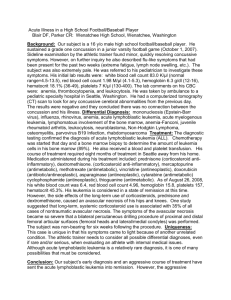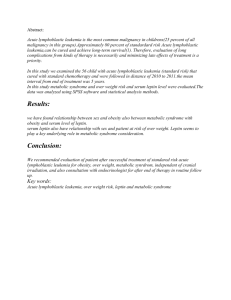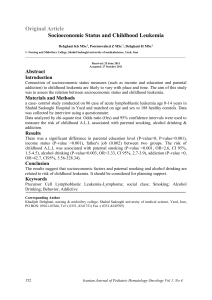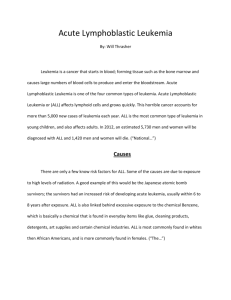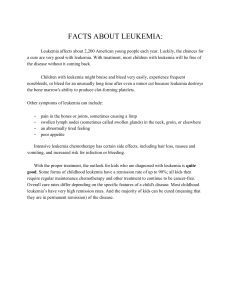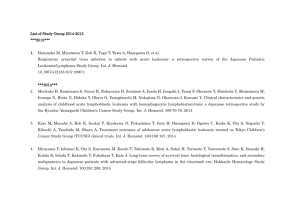Marchant
advertisement
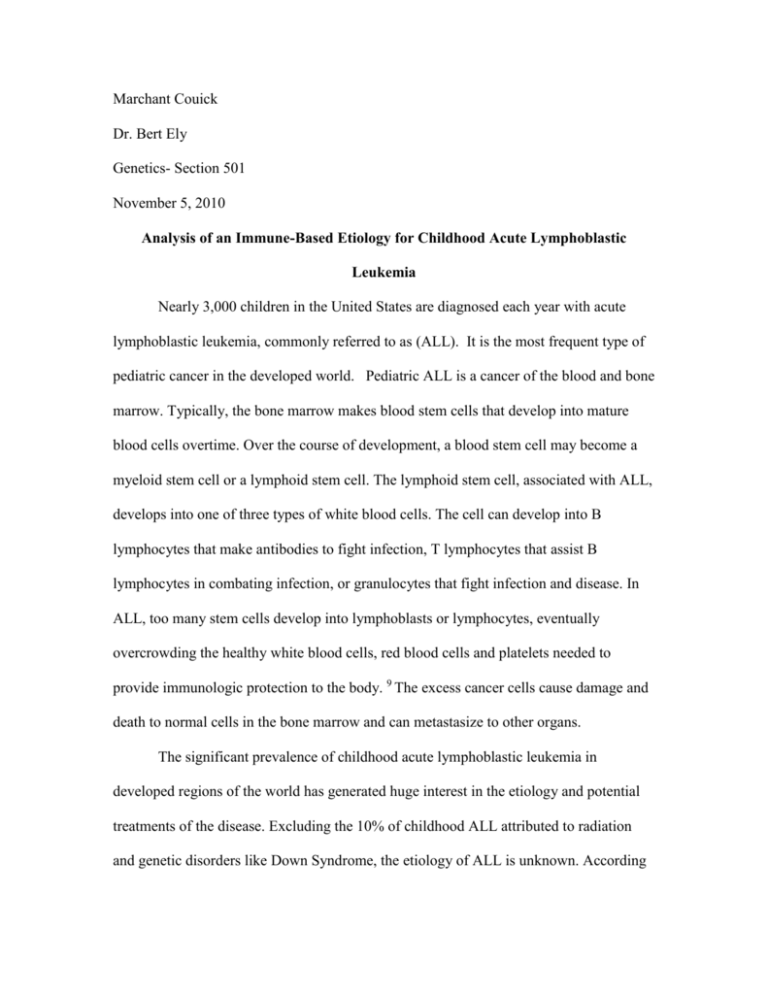
Marchant Couick Dr. Bert Ely Genetics- Section 501 November 5, 2010 Analysis of an Immune-Based Etiology for Childhood Acute Lymphoblastic Leukemia Nearly 3,000 children in the United States are diagnosed each year with acute lymphoblastic leukemia, commonly referred to as (ALL). It is the most frequent type of pediatric cancer in the developed world. Pediatric ALL is a cancer of the blood and bone marrow. Typically, the bone marrow makes blood stem cells that develop into mature blood cells overtime. Over the course of development, a blood stem cell may become a myeloid stem cell or a lymphoid stem cell. The lymphoid stem cell, associated with ALL, develops into one of three types of white blood cells. The cell can develop into B lymphocytes that make antibodies to fight infection, T lymphocytes that assist B lymphocytes in combating infection, or granulocytes that fight infection and disease. In ALL, too many stem cells develop into lymphoblasts or lymphocytes, eventually overcrowding the healthy white blood cells, red blood cells and platelets needed to provide immunologic protection to the body. 9 The excess cancer cells cause damage and death to normal cells in the bone marrow and can metastasize to other organs. The significant prevalence of childhood acute lymphoblastic leukemia in developed regions of the world has generated huge interest in the etiology and potential treatments of the disease. Excluding the 10% of childhood ALL attributed to radiation and genetic disorders like Down Syndrome, the etiology of ALL is unknown. According to the American Cancer Society, the five-year survival rate for children diagnosed with ALL is more than 85% overall. With the advent of advanced research methods and treatment options, the improvement in survival for children over the past 35 years has increased by 80%.1 Despite the remarkable strides made in the field, questions remain concerning the multifactorial causes of pediatric ALL. The focus of this paper is to examine the possibility of an immune related etiology for childhood acute lymphoblastic leukemia. In the late 1980s two infection-based hypotheses for childhood ALL were proposed: Kinlen’s “population-mixing” hypothesis and Greaves’ “delayed infection” hypothesis.[3,4] Kinlen suggested that the increased incidence of childhood leukemia had infectious origins as a result of atypical population mixing. He proposed that communities with recently combined rural and urban populations would have a higher incidence of childhood leukemia due to a lack of exposure to the other group’s viruses. Greaves asserted that the genesis of pediatric leukemia involved a two-step temporal model. According to this model leukemia is initiated through chromosomal translocations in utero and again after birth through secondary genetic changes, ultimately causing the overt disease.3 Much of the current research on ALL focuses on identifying the second postnatal event in the development of clinical leukemia where a pre-leukemic cell is converted into a leukemic cell. 3 Both hypotheses underscore the development of abnormal immune response and its correlation to childhood leukemia. The mechanism through which children obtain the disease remains unclear, but the overwhelming majority of research performed today revolves around these two explanations. The current body of literature specifically observing and testing the hypotheses of Kinlen and Greaves is diverse. Some studies show significant support for an immune based etiology while others are inconclusive or find no correlation. In a review compiled by Ma et al., 14 studies testing the immunity-based etiology of ALL produced a statistically significant summary odds ratio of 0.77 for children attending daycare either before age one or two, or between birth to diagnosis. The 14 studies combined represent over 6,000 ALL leukemia cases. Taken together, the studies suggest that exposure to infectious agents early in life through daycare attendance or other social contacts is significantly protective against childhood ALL. 4 Similarly, a study performed by Schuz et al. identified correlations between immunity and increased risk of developing ALL. Their comprehensive case-control study, conducted between 1992 and 1997, examined various risk factors highlighted by Greaves such as birth order, duration of breastfeeding, infectious disease and which routine immunizations had been performed.8 Nearly 4,000 participants were used in the study. In all, 1184 families of children with leukemia and 2588 families with control children participated. Their results indicated that birth order was very weakly associated with leukemia (p=.05). Also, children with fewer immunizations had a greater risk of developing ALL compared to children who were immunized for six diseases or more. The study identified a dose-response relationship between the number of immunizations received and risk. The association was more exaggerated for children aged 3 years or less with a 10.5- fold increase in risk in those children with 3 immunizations or less. The study provides weak support for Greaves’ hypothesis due to the statistical insignificance of categories such as birth order and breastfeeding (p>.05).8 Other studies suggest a strong correlation between hypothesized risk factors and ALL. In an experiment performed by Macarthur et al., examining the risk associated with vaccination and medication, there was evidence to suggest a role for early immunologic challenge in the expression of childhood leukemia. Their data indicated that the use of immunosuppressant medication by the study subjects led to a decrease in risk (odds ratio 0.37, 95% confidence interval: 0.16, 0.84), while vitamin intake proved to increase risk of developing the disease (odds ratio 1.66, 95% confidence interval: 1.18, 2.33).5 In contrast to the aforementioned study, this one indicated that breastfeeding for more than 6 months was protective to a child (p<.05). This correlation is particularly significant due to that fact that human milk contains a variety of microbial activity able to jumpstart a child’s immune system in comparison with artificially fed infants. 5 Following the trend in the studies discussed above, an experiment examining the patterns of day care attendance and infection, revealed correlations with immunity and childhood ALL. Neglia et al. conducted a case-control study of 1842 newly diagnosed and immunophenotypically defined cases of ALL under age 15, and 1986 matched controls.6 The research team collected data based on day care attendance, birth order and common childhood infections gathered through parental interviews. Their analysis revealed that there was no significant correlation between daycare attendance and risk of ALL. However, unique to the study presented by Neglia et al. was the fact that ear infections during infancy were less common among cases, with odds ratios of 0.86, 0.83, 0.71 and 0.69 for 1, 2–4, 5+ episodes, and continuous infections respectively (trend P = 0.026).6 They concluded that there was not strong enough evidence of correlations between infection and childhood ALL risk to assume an immune-based etiology, excluding ear infections. Similarly, an experiment testing specific genetic polymorphisms in adaptive immunity genes distinguished several strong correlations between immunity pathways and ALL. Subjects were recruited by the Northern California Childhood Leukemia Study (NCCLS), a case control study that began in 1995. Major medical centers in 17 counties in the San Francisco Bay Area were included in the study from 1995 to 1999, and 18 additional counties in the California Central Valley were added in 1999.2 In total, 377 ALL cases and 438 healthy controls were used in the experiment. Recently, Chang et al. 2 analyzed associations between childhood ALL and 208 polymorphisms of 29 adaptive immune function genes in the development and function of Th1, Th2, T regulatory and Th17 cells. Among the 235 single nucleotide polymorphism (SNPs) tests performed, 19 were statistically significant (p<.05). These 19 single SNPs appear in 10 genes involved in the development and function of different immune cells. However, only rs583911 of IL12A remained significant after a correction for multiple tests (P=2.9*10^-5). The increased risk associated with each copy of the specific allele appeared stronger among first born children (OR, 2.14; 95% CI, 1.523.01). They concluded that the polymorphism in the adaptive immunity pathway was associated with childhood ALL risk, supporting both Greaves and Kinlen’s hypotheses.2 Further fine mapping and functional study of the region was suggested to determine causal variants. The data presented in this experiment is particularly valuable as it offers a specific mechanism through which ALL interacts with immunologic pathways, making it easier for doctors to create selectively targeted treatments for individual cases. In order to revolutionize, the treatment of childhood acute lymphoblastic leukemia much work must be done. According to multiple sources, the infection and immunity hypothesis would hold more weight if further evidence for the mechanisms of the “second hit”, the postnatal event that causes the leukemia to appear clinically, could be modeled and the specific cellular and biochemical mechanisms could be identified.[4,7,8] As previously highlighted in the study conducted by Chang et al., the key to identifying the etiology of ALL is to observe those genes that encode critical components of the immune network.2 The study presented by Chang et. al is just the tip of the iceberg. We are now entering a phase guided by Greaves’ two-step temporal model of leukemogenesis where identifying specific mechanisms is viable and perhaps the most efficient way to identify immune-based etiologies in ALL. Leading researchers across the globe are working to understand the outcomes of arising genetic lesions in patients and their effects on the cell. 7 A better understanding of the complex interactions between genes and their environment will allow them to devise individualized treatment plans.7 In the near future individual molecular therapy may one day replace chemotherapy, radiation and stem-cell transplantation as a treatment for ALL. These new approaches to treatment promise fewer lifelong ramifications, as seen with radiation and chemotherapy, giving children a greater chance at a fulfilled life. Works Cited 1. "Acute Lymphoblastic Leukemia in Children - National Cancer Institute." National Cancer Institute - Comprehensive Cancer Information. Web. 02 Nov. 2010. <http://www.cancer.gov/cancertopics/factsheet/sites-types/all-in-children>. 2. Chang, Jeffrey S., Joseph L. Wiemels, Anand P. Chokkalingam, Catherine Metayer, Lisa F. Barcellos, Helen M. Hansen, Melinda C. Aldrich, Neela Guha, Kevin Y. Urayama, Ghislaine Scelo, Janet Green, Suzanne L. May, Vincent A. Kiley, John K. Wiencke, and Patricia A. Buffler. "Genetic Polymorphisms in Adaptive Immunity Genes and Chilhood Acute Lymphoblastic Leukemia." Cancer Epidemiology Biomarkers 19 (2010): 2152-163. Web. 3. Greaves, Mel. "Infection, Immune Responses and the Aetiology of Childhood Leukemia." Nature Reviews-Cancer 6.3 (2006): 193-203. Print. 4. Ma, Xiaomei, Kevin Urayama, Jeffrey Chang, Joseph Wiemels, and Patricia Buffler. "Infection and Pediatric Acute Lymphoblastic Leukemia." Blood Cells, Molecules, and Diseases 42.2 (2009): 117-20. Web. 01 Nov. 2010. <http://www.ncbi.nlm.nih.gov/pubmed/19064328>. 5. MacArthur, A. C., M. L. McBride, J. J. Spinelli, S. Tamaro, R. P. Gallagher, and G. P. Theriault. "Risk of Childhood Leukemia Associated with Vaccination, Infection, and Medication Use in Childhood: The Cross-Canada Childhood Leukemia Study." American Journal of Epidemiology 167.5 (2007): 598-606. Print. 6. Neglia, JP, MS Linet, XO Shu, RK Severson, JD Potters, AC Mertens, W. Wen, JH Kersey, and LL Robison. "Patterns of Infection and Day Care Utilization and Risk of Childhood Acute Lymphoblastic Leukemia." British Journal of Cancer 82.1 (1999): 234-40. Print. 7. Pui, CL. "Acute Lymphoblastic Leukemia." The Lancet 371.9617 (2007): 1030-043. Print. 8. Schuz, J., U. Kaletsch, R. Meinert, P. Kaatsch, and J. Michaelis. "Association of Childhood Leukaemia with Factors Related to the Immune System." British Journal of Cancer 80.3: 585-90. Web. 9. St. Jude Children's Research Hospital. Acute Lymphoblastic Leukemia-Disease Informaiton. Web. 1 Nov. 2010. <http://www.stjude.org/stjude/v/index.jsp?vgnextoid=4c5b061585f70110VgnVC M1000001e0215acRCRD&vgnextchannel=bc4fbfe82e118010VgnVCM1000000 e2015acRCRD&SearchUrl=search_results.jsp&QueryText=acute lymphoblastic leukemia>.

